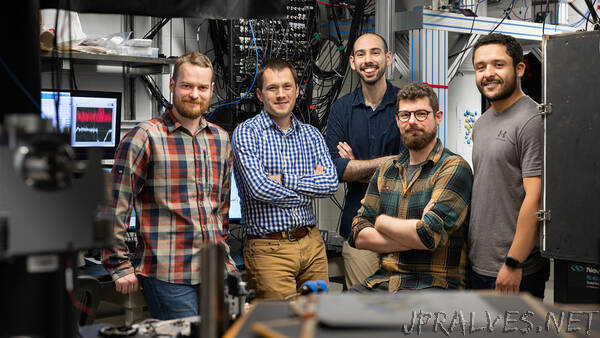
“Researchers have a new way to connect quantum devices over long distances, a necessary step toward allowing the technology to play a role in future communications systems.
While today’s classical data signals can get amplified across a city or an ocean, quantum signals cannot. They must be repeated in intervals — that is, stopped, copied and passed on by specialized machines called quantum repeaters. Many experts believe these quantum repeaters will play a key role in future communication networks, allowing enhanced security and enabling connections between remote quantum computers.
The Princeton study, published Aug. 30 in Nature, details the basis for a new approach to building quantum repeaters. It sends telecom-ready light emitted from a single ion implanted in a crystal. The effort was many years in the making, according to Jeff Thompson, the study’s principal author. The work combined advances in photonic design and materials science.
Other leading quantum repeater designs emit light in the visible spectrum, which degrades quickly over optical fiber and must be converted before traveling long distances. The new device is based on a single rare earth ion implanted in a host crystal. And because this ion emits light at an ideal infrared wavelength, it requires no such signal conversion, which can lead to simpler and more robust networks.
The device has two parts: a calcium tungstate crystal doped with just a handful of erbium ions, and a nanoscopic piece of silicon etched into a J-shaped channel. Pulsed with a special laser, the ion emits light up through the crystal. But the silicon piece, a whisp of a semiconductor stuck onto the top of the crystal, catches and guides individual photons out into the fiber optic cable.
Ideally, this photon would be encoded with information from the ion, Thompson said. Or more specifically, from a quantum property of the ion called spin. In a quantum repeater, collecting and interfering the signals from distant nodes would create entanglement between their spins, allowing end-to-end transmission of quantum states despite losses along the way.
Thompson’s team first started working with erbium ions several years before, but first versions used different crystals that harbored too much noise. In particular, this noise caused the frequency of the emitted photons to jump around randomly in a process known as spectral diffusion. This prevented the delicate quantum interference that is necessary to operate quantum networks. To solve this problem, his lab started working with Nathalie de Leon, associate professor of electrical and computer engineering, and Robert Cava, a leading solid-state materials scientist and Princeton’s Russell Wellman Moore Professor of Chemistry, to explore new materials that could host single erbium ions with much less noise.
They winnowed the list of candidate materials from hundreds of thousands down to a few hundred, then a couple dozen, then three. Each of the three finalists took half a year to test. The first material turned out to be not quite clear enough. The second caused the erbium to have poor quantum properties. But the third, the calcium tungstate, was just right.
To demonstrate that the new material is suitable for quantum networks, the researchers built an interferometer where photons randomly pass through one of two paths: a short path that is several feet long, or a long path that is 22 miles long (made of spooled optical fiber). Photons emitted from the ion can go on the long path or the short path, and about half the time, consecutive photons take opposite paths, and arrive at the output at the same time.
When such a collision occurs, quantum interference causes the photons to leave the output in pairs if and only if they are fundamentally indistinguishable — having the same shape and frequency. Otherwise, they leave the interferometer individually. By observing a strong suppression — up to 80 percent — of individual photons at the interferometer output, the team proved conclusively that the erbium ions in the new material emit indistinguishable photons. According to Salim Ourari, a graduate student who co-led the research, that puts the signal well above the hi-fi threshold.
While this work crosses an important threshold, additional work is required to improve the storage time of quantum states in the spin of the erbium ion. The team is currently working on making more highly refined calcium tungstate, with fewer impurities that disturb the quantum spin states.
The paper, “Indistinguishable telecom band photons from a single erbium ion in the solid state,” was published in the journal Nature with the support of the U.S. Department of Energy, Office of Science, National Quantum Information Science Research Centers, Co-design Center for Quantum Advantage (C2QA). In addition to Thompson, Cava and Ourari, authors include Łukasz Dusanowski, Sebastian P. Horvath, Mehmet T. Uysal, Christopher M. Phenicie, Paul Stevenson, Mouktik Raha, Songtao Chen and Nathalie de Leon. Ourari, Dusanowski, Horvarth and Uysal all contributed equally.”
